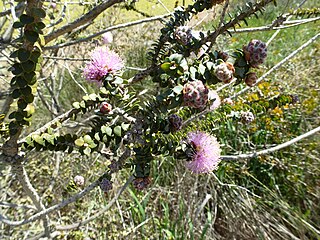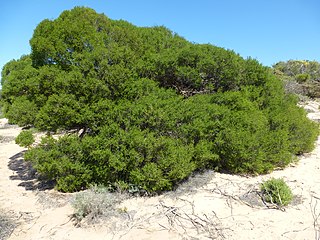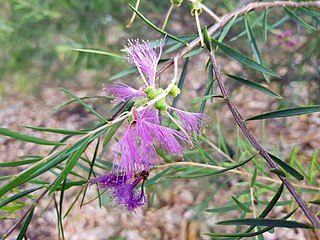Melaleuca eximia is a plant in the myrtle family, Myrtaceae and is endemic to the south of Western Australia. It is distinguished by its leaf arrangement, its large, showy red inflorescences and the large, furry bracts under the flowers.

Melaleuca hnatiukii is a plant in the myrtle family, Myrtaceae and is endemic to the south of Western Australia. It is a medium to large shrub with arching branches, prickly tipped leaves and creamy-white heads of flowers in spring or early summer.
Melaleuca idana is a plant in the myrtle family, Myrtaceae, and is endemic to the south-west of Western Australia. It is a small shrub with fine, silky hairs covering the new foliage and heads of pink to deep purple flowers in early spring. It is similar to Melaleuca sapientes, differing mainly in the shape of the leaves in cross-section and the length of its styles.
Melaleuca lara is a plant in the myrtle family, Myrtaceae and is endemic to a small area on the west coast of Western Australia. It is similar to Melaleuca ciliosa with its hairy young leaves and heads of yellow flowers ageing to red but there are fewer flowers in each head and the leaves are generally smaller.

Melaleuca nematophylla, commonly known as wiry honey-myrtle is a plant in the myrtle family, Myrtaceae and is endemic to the south-west of Western Australia. It is one of the showiest melaleucas when in flower in early spring, is easily grown and has unusual needle-like foliage. As a result, it is relatively common in cultivation in temperate parts of Australia.

Melaleuca orbicularis is a plant in the myrtle family, Myrtaceae and is endemic to the south-west of Western Australia. It is similar to Melaleuca cordata with its pinkish "pom-pom" heads of flowers but its leaves are smaller, almost circular compared to the heart shaped leaves of the other species.

Melaleuca phoidophylla is a plant in the myrtle family, Myrtaceae and is endemic to the south-west of Western Australia. It is distinguished by its leaf arrangement, small raised blisters on the leaves and heads of white or cream flowers on the ends of the branches in spring.

Melaleuca podiocarpa is a plant in the myrtle family, Myrtaceae and is endemic to the south-west of Western Australia. It is a spreading shrub with prickly foliage and small heads of white flowers mostly hidden within the foliage.

Melaleuca ryeae is a plant in the myrtle family, Myrtaceae and is endemic to the south west of Western Australia. It is a small shrub, closely resembling Melaleuca amydra with its small leaves and profuse heads of pink to purple flowers but M.amydra has narrower leaves and does not have spherical clusters of fruits.
Melaleuca venusta is a shrub in the myrtle family Myrtaceae and is endemic to the west coast of Western Australia. It is a shrub with silvery leaves and heads of pink to purple flowers which fade to white and with a restricted distribution, north of the Murchison River district.

Melaleuca coccinea, commonly known as the goldfields bottlebrush is a shrub in the myrtle family Myrtaceae and is endemic the south of Western Australia. It is distinguished by its unusual foliage and bottlebrush spikes of red flowers.

Melaleuca leiocarpa, commonly known as pungent honey-myrtle, is a plant in the myrtle family, Myrtaceae and is native to arid areas in parts of South Australia and Western Australia. It is an erect or branching shrub distinguished by its prickly foliage, yellowish flowers and, for a melaleuca, unusually large, smooth, roughly spherical fruits.

Melaleuca cardiophylla, commonly known as tangling melaleuca or umbrella bush is a plant in the myrtle family, Myrtaceae and is endemic to the west and south-west of Western Australia. It is a dense, prickly shrub with heart-shaped leaves, stamens that are joined in unusually long claw-like bundles, and distinctive, warty fruits.

Melaleuca concreta is a plant in the myrtle family Myrtaceae and is endemic to the south-west of Western Australia. The species name (concreta) refers to the way the fruits are tightly packed together.

Melaleuca marginata is a shrub in the myrtle family, Myrtaceae and is endemic to the south-west of Western Australia. It is distinguished by its prickly leaves and its flowers occurring in long sections of the branches. From 1922 to 2011 was known as Melaleuca coronicarpa.

Melaleuca lateriflora, commonly known as gorada, is a plant in the myrtle family, Myrtaceae and is endemic to the south-west of Western Australia. It is usually an erect shrub with oval leaves and small clusters of white flowers mainly along the older branches.

Melaleuca spectabilis is a plant in the myrtle family, Myrtaceae, and is endemic to the south-west of Western Australia. It was formerly known as a subspecies of Melaleuca longistaminea. It is a low, prickly shrub with yellow or lime-green flowers in spring and early summer.
Melaleuca calcicola is a plant in the myrtle family, Myrtaceae and is endemic to the south of Western Australia. It was formerly known as a subspecies of Melaleuca apodocephala but was reassessed in 2010 and raised to species status. Its branches are corky, the leaves pointed although not prickly and the flowers are creamy white, tipped with yellow.
Melaleuca fulgens subsp. fulgens, commonly known as the scarlet honey myrtle, is a plant in the myrtle family, Myrtaceae and is endemic to the south-west of Western Australia. In 1990, the species Melaleuca fulgens was separated into 3 subspecies and this is the most widespread of them. As with the other two subspecies, this one is notable for its showy flowers which are usually red but its foliage and fruits are also attractive features.

Melaleuca fulgens subsp. steedmanii, commonly known as the scarlet honey myrtle, is a plant in the myrtle family, Myrtaceae and is endemic to the south-west of Western Australia. In 1990, the species Melaleuca fulgens was separated into 3 subspecies. Of the two subspecies occurring in the south-west, this one has the narrower distribution, occurring mainly near Geraldton. As with the other subspecies, this one is notable for its showy flowers which are usually red but its foliage and fruits are also attractive features.
















